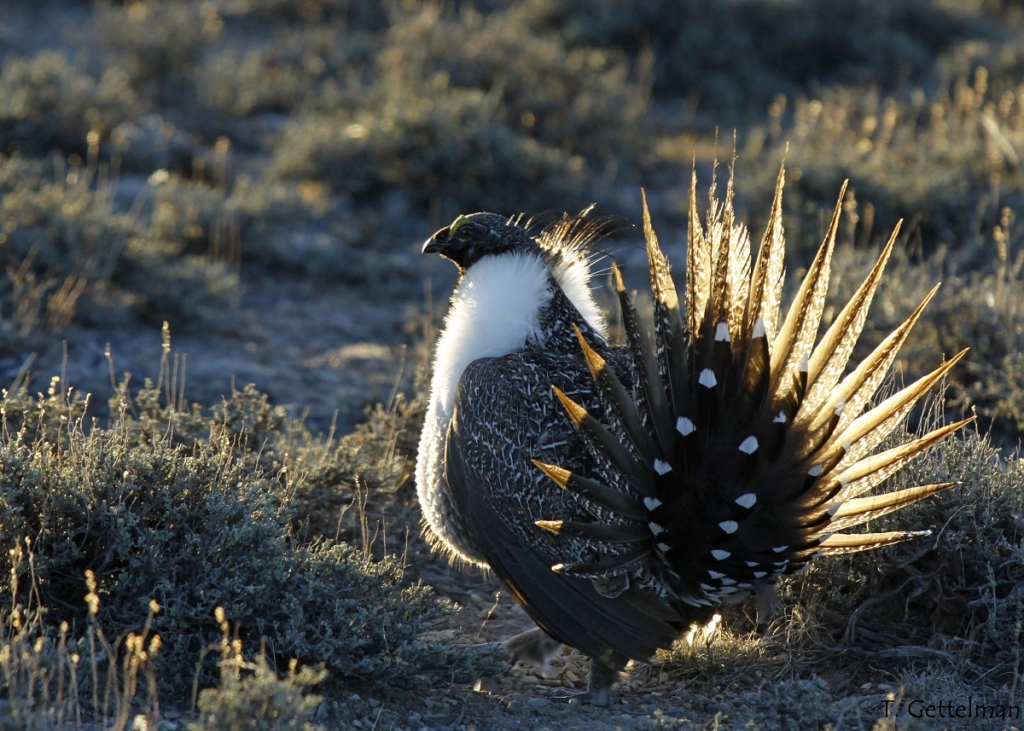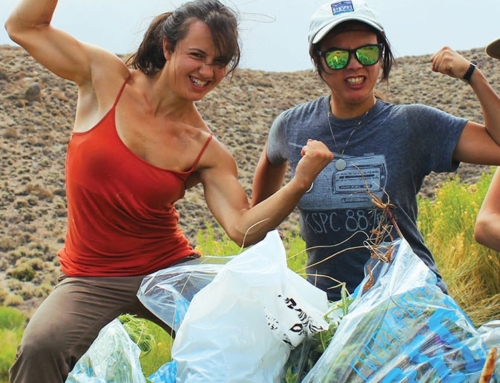
Photo by Bob Wick, BLM.
Would you like to be a part of our conservation success stories? At the bottom of this article, you can read about an opportunity to volunteer with us next month as we care for Bi-State sage-grouse habitat.
Bi-State sage-grouse on the border of California and Nevada are a genetically distinct population of sage-grouse, and are a loved species here in the Eastern Sierra. But due to habitat loss, these treasured birds are at risk of decline.

Photo by Tatiana Gettelman
Sage-grouse live on many of our conservation easements and over the years, our team here at Eastern Sierra Land Trust has taken part in different conservation projects to improve their habitat on the eastside. These projects include installing fence tags on barbed wire fences, adding perch deterrents to fence posts, and removing pinyon and juniper trees encroaching sagebrush ecosystems. We’ve worked with volunteers, landowners, and conservation partners such as Sage Grouse Initiative, Audubon Society, U.S. Forest Service, and Bureau of Land Management (BLM) to accomplish this work.
Many of these projects have taken place on working farms and ranches such as Sinnamon Meadows, Conway Ranch, and Sceirine Point Ranch. Because of California and Nevada ranchers’ stewardship, the Bi-State greater sage-grouse tend to thrive together with livestock. Ranchlands often provide an ideal combination of sagebrush and wet meadow ecosystems, creating perfect conditions for sage-grouse to raise their chicks.
Perhaps the greatest threat to sage-grouse habitat and survival in the Bi-State is the encroachment of pinyon and juniper trees into sagebrush habitat. These tree species are native to the higher rocky hillsides, but they’ve creeped into shrub systems due to human modification of natural fire patterns. Sage-grouse, pygmy rabbits, and other animals in the sage-steppe did not evolve with these invading trees. Conifer trees provide perches for predators and also modify their surroundings, changing the sagebrush ecosystem to woodland. What’s more, a single pinyon or juniper tree removes 35 gallons of water a day from the sagebrush system, which increases the pace of change from healthy sagebrush steppe to invasive woodland.
Here at Eastern Sierra Land Trust, we provide and restore habitat for wildlife like the Bi-State sage-grouse. In 2018, the BLM and the U.S. Forest Service awarded us the National Conservation Leadership Partner Award for leadership in the implementation of conservation programs and activities that benefit fish, wildlife, and native plants. Would you like to be a part of this conservation story? We have an opportunity for you to join us to improve habitat for Bi-State sage-grouse this September!
We will be partnering with BLM on September 6 and 7 for two full days of sage-grouse habitat enhancement near Bridgeport and Bodie. If you are interested, please reach out to Marie Ring at or call our office at 760-873-4554. Join us this September, and see the impact of what your hands on the land can do for this species.







